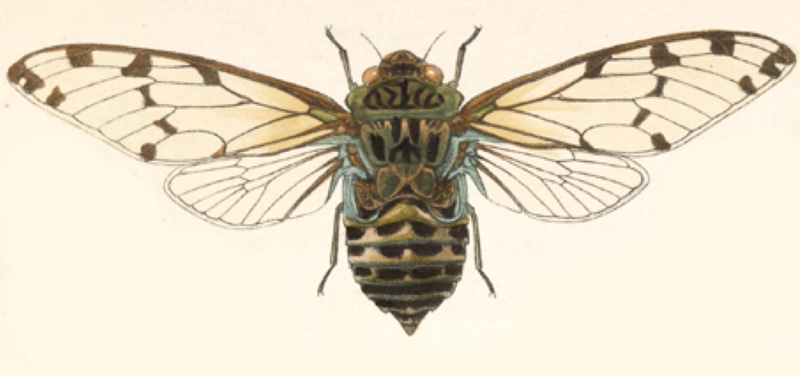A news story came out in November reporting that M. cassini appeared in areas of Connecticut where they were not expected during the Brood II emergence this year. This must have been a 2013 highlight for cicada researchers in the Connecticut area.
Cicada News for November 2013
There were plenty of cicada sightings in Australia this November, like…
This Masked Devil (Cyclochila australasiae), photo taken by Kipp Droby.
A Cyclochia australiasiae with a “bitza” (little bit of everything) paint job — part Yellow Monday; part Masked Devil, by photographer Alan Davison.
A Green Grocer with many shades to green, by a photographer named Howard.
A nice blog post about Australian cicadas, by the Barnade Goose Paperworks.
A chilling video of a moulting cicada being attacked by ants.
A Redeye Cicada (Psaltoda moerens), photo taken by Michael Doe.
This banana-yellow Yellow Monday:
Tom Katzoulopolopolopolus found this amazingly yellow C. australasiae aka "Yellow Monday" in Galston, NSW, Australia. pic.twitter.com/IOWgKvworD
— Cicada Mania (@cicadamania) November 27, 2013
Double Drummers, like:
@cicadamania what kind of cicada is this? pic.twitter.com/WsNkcvaZfe
— georgie (@GEORGIE132) November 15, 2013
Or a Double Drummer and Razor Grinder:
Or this pair of Urabunana marshalli found south of Coolah, NSW by David Emery:
Macro photo of a Floury Baker
Cicada – The Insect Methuselah
I picked up a film on 16mm (what they showed to kids in school before VHS tapes were popular) called Cicada – The Insect Methuselah. I would love to see it, but I don’t have a 16mm projector (who does?) The film is presumably about 17/13 Year cicadas. I held the film up to a light, and it indeed features the Magicicada species.
The film was produced by the Moody Institute of Science in 1955, and I assume they still hold the copyright to the film. It is 12 minutes in length.
Update: Roy Troutman contacted us to let us know that this video footage can be found in another video: The Mystery of The Three Clocks, which you can watch here:
The most impressive thing about the video is the anatomical model of the cicada. I wish I had one (but I might have to go back to the 50’s to get one).
This video taken by Samantha Madell in NSW Australia is a time lapse video of of a Redeye Cicada (Psaltoda moerens) molting.
A Cicada Attacked by Bull Ants
Poor, poor cicada — never had a chance. Here’s a video of bull ants attacking a molting cicada:
via Twitter
There's no wonder a Bull Ant bite hurts! Cicada Attacked by Bull Ants @Myrmecos @cicadamania http://t.co/qbfldbbqgs
— Anne Brophy (@BrophyAnne) November 20, 2013
March of the cicadas
Now that is a lot of cicada skins!
A moulting cicada in NSW Australia
This cicada photo was taken by photographer Cameron George about 60km south of Sydney Australia. I believe this is a Green Grocer, but I’m not 100% sure. The cicada is attempting to molt.
A new species of Tibicen cicada, Tibicen neomexicensis, has been described by Brian J. Stucky.
Thanks to David Marshall for the tip.
Just in time for Halloween… the Zammara a genus of cicadas with a collar like Dracula!
Andreas Kay has been posting photos of the insects of Ecuador on Flickr for around a year now. He’s posted many excellent cicada photos, particularly, photos of Zammara. They are among the most visually interesting cicadas.
Emerald Cicada, Zammara smaragdina:
Here’s an illustration from Insecta. Rhynchota. Hemiptera-Homoptera. Vol. I by W. L. Distant and The Rev Canon W. W. Fowler, F.L.S:

Here the Scientific classification:
Family: Cicadidae
Subfamily: Cicadinae
Tribe: Zammarini
Genus: Zammara
Species: Zammara smaragdina Walker, 1850
Here’s an article about Collared cicadas of Mexico, Central & South America.







